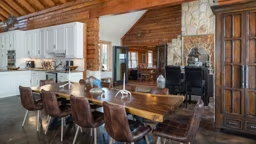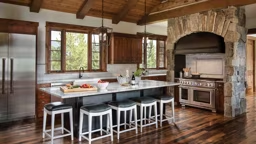
Style is a word that often comes to mind in planning great rooms and primary bedrooms, but it is every bit as important — if not more so — in the kitchen as in any room of the home. Let’s face it: We all gravitate to the kitchen. Far from being a strictly utilitarian corner of the house, shut off from the home’s flow, today’s kitchens are the hub where much family activity has its basis.
As you are determining the types of appliances you’ll need and the work pattern that will be critical to feeling at home in the space, you also are well served to be thinking about how to integrate the kitchen’s style with the rest of your log home. And the good news is that if you’ve already settled on a style for the other rooms, there is no reason it can’t be brought into the kitchen as well.
Here are the most common kitchen styles and some of the elements that define them.
1. Traditional Style
There is a good reason that Traditional out-paces all other styles: It will wear well for many years to come. Traditional plans avoid the pitfalls of being just a little too trendy, instead emphasizing comfort and long-term enjoyment. This style embraces and combines much of what has been enjoyable for the last 200 years: There is symmetry and balance in all the elements.
Cabinetry is usually from an enduring wood species, such as oak, cherry, maple and mahogany. That much variation in color opens the door for a wide range of additional elements, too. Countertops are often granite or marble, while floors are sensible, if lovely, tile. A sense of formality is achieved in detail such as rosettes, hand-carved trim and crown moldings that also avoid overwhelming or fussy accents. Curtains and upholstered seating add warmth and texture, and it’s not unusual for heirlooms and fine china to be on display in hutches or open-front cabinets.
Far and away the most important element to defining the Traditional look is the use of natural materials. If it came from the earth, it’s probably going to fit right in.
2. Country Style
This is Traditional taken a step or ten further. Again, the emphasis is on nature, but less conservatively. Instead of close-grained woods, Country loves pine, hickory and alder with their greater flair. In fact, cabinets are sometimes mix-and-match in size and style, and might leave off doors to simulate what would have been found in an 1800s Appalachian-home kitchen. Lighter, brighter colors overall grace the walls and the accents. Wood plank floors are popular, as are beamed ceilings from which herbs and flowers can dry. Hand-painted tiles make a charming backsplash.
An outgrowth of this style is the Western look, which is simply a refinement with mountain and desert sensibilities. It features earthier colors and simpler lines, but the overall effect is one of comfort and lived-in enjoyment.
3. Arts and Crafts (Mission) or Shaker Style
There are differences for the designer who chooses to strictly adhere to either style, but for the relaxed log home, mixing elements is always a delight. As with both Traditional and Country styles, the emphasis is on natural materials. Here, however, the lines are more austere and simplified. While clutter and kitsch can be found in Country, and grandchildren’s artwork often adorns the fridge of a Traditional kitchen, Arts and Crafts/Shaker evokes disciplined and sparing lines. However, with the emphasis on beautiful pieces of oak, maple or birch (and the more wood the better), the rich patina and character of the grain becomes the focal point. Craftsmanship and subtlety are the hallmarks of this style.
For color, stylists often select Tiffany lamps and stained-glass windows or cabinet panels. Used sparingly, brief bursts of color against a background of natural hues are always effective in adding warmth and charm. Flush-framed cabinetry and simple hardware (if any) from pewter or hammered brass works effectively with simple-to-absent window treatments.
And therein lies the secret. Those who enjoy minimalist surroundings are usually and naturally drawn to the unassuming, yet evocative Arts and Crafts/Shaker style.
4. Old World Provincial Style
Traditional styling is the natural North American outgrowth of the European approach, which is called by a variety of names, from French Chateau to English Formal to Italianate to Old World Provincial. No matter what name is applied, it is a style that ties the genuine antique to modern convenience.
Ceiling beams are nearly universal in this style, and the more aged they appear, the better served will be the rest of the elements. Wood floors with the appearance of long-term use add even more charm. Finely grained, richly colored wood is preferred, although sometimes cabinets will be painted in muted and glazed tones from dark red to gray-blue. Cabinetry and islands often have carved legs and feet, and sometimes feature mismatched species to add more character. Other natural materials, such as brick, stone and mosaic tiles, are intrinsic to creating the finished look.
A fireplace truly stamps the room as Old World-influenced, and that means as large a hearth as the room can stand without throwing off the scale. Wrought-iron hardware, chandeliers and accents are other identifiers.
Because the kitchen was truly the center of family life in Europe for many centuries, in newer adaptations, the cabinets take on the look of furniture, often also hiding appliances. Dressers and armoires find new life in these types of kitchens, too.
And if it all sounds too heavy for your log home, put a Tuscan spin on your plans. This sunny region of Italy promotes lighter, brighter hues with a refined, but rustic flair.
5. Contemporary Style
This is the style that is most difficult to integrate into a log home, but it is so popular today that it warrants consideration. Also known as Mid-Century Modern or Scandinavian, Contemporary is all about clean and simple lines with angular corners and either no hardware on cabinetry or oversized metal. Chrome, stainless steel and glass are hallmark materials, but so are stone and concrete, while neutrally colored brick or wood can also be used. Colors tend to be monochromatic, often featuring white or black as the starting point. Other primary, solid color tends to be used in startling bursts. The overall emphasis is on manufactured materials rather than natural ones, but innovative designers have figured out how to bring natural materials, such as bamboo, marble and granite, into the design.
Taking into account the natural warmth of logs, utilizing Contemporary can be a lot more challenging than other styles, but it’s not impossible. Often, it is just a matter of juxtaposing a variety of elements and styles.
Regardless of the kitchen style you decide upon for your log home, remember always to keep it cohesive with the rest of the home’s design and decor. A jarring transition is no transition at all. And with the enormous range of materials available these days, any style — or mix of styles — is easier to pull together than a dinner for six.











